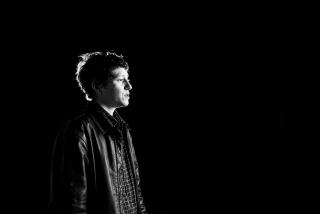JAZZ REVIEW : A Less Tangled Approach Puts Spotlight on Ravel : By making due with less in his El Matador show, the keyboardist gives his ‘Midnight Passion’ tunes a streamlined appeal missing from the album. The focus shows off his composing and pianistic abilities.
- Share via
HUNTINGTON BEACH — Less was more here Saturday at El Matador as keyboardist Freddie Ravel took the bandstand to perform tunes from his recent “Midnight Passion” recording. The album, which has made charts in the United States and in Japan, has a lush, tropical feel and involves as many as two guitars and percussionists on some cuts, with the occasional saxophone or flute thrown in for good measure.
But the group Ravel fronted at El Matador made due without added ingredients, giving it a streamlined appeal missing from the record. The stripped-down version heard here, basically a keyboard, bass and drums setup with added depth from vocalist and sometimes keyboardist-percussionist Anjani Thomas, put the focus squarely on Ravel’s composing and pianistic abilities.
Ravel, a native of Los Angeles and veteran of work with Sergio Mendes, shows a strong Brazilian influence in his writing, a feel that he anchors with firm, up-tempo bass rhythms or R&B-flavored; ballad lines. While the tunes are easily accessible--an attribute that’s even more apparent without the clutter of guitars or horns--Ravel works in enough compositional variety to avoid tedious riffs or too-predictable chordal changes.
Just when his ballads threatened to become repetitively sweet, they slipped into a minor-key feel, or moved through a sweeping dynamic change before a cooling return to the original theme. The more upbeat numbers showed the same anything-can-happen sense, with rhythmic double-times or stop-dead breaks coming just when the patterns started to wear thin.
Using a breath controller, a mouth-held device that allows him to control the strength of his keyboard tones, Ravel worked instrumental lines from the Herbie Hancock-Chick Corea electric school that he peppered with trills and chordal splash. Rather than depend on wild swings between a large number of harsh, unnatural tones, a practice so many electric keyboardist use these days, he stayed with a small number of piping-clean sounds from his synthesizer. Ravel also displayed an intelligent sense of drama, building logically to climaxes that were neither overly showy or long.
Singer Thomas played a large role in sustaining the music’s interest with warm, sometimes steamy vocal musings and appropriate percussive touches from a variety of hand-sized instruments. The singer also contributed to the writing of a number of the selections, and though there’s nothing especially innovative about the words to a tune such as “Jasmine Breeze,” Thomas’ clarity and expressiveness made the blandness of the lyric easy to overlook.
Stirred up by bassist Jerry Watts’ powerful shuffle, “A Slice of Heaven” moved between a relaxed, lazy-afternoon mood and more serious instrumental passages that Thomas tracked on a keyboard of her own. A new Ravel tune not heard on “Midnight Passion,” “Dance for the Sol” worked a funky bass line against Ravel’s church organ tones while Thomas added wordless vocal touches that brought out the tune’s heat.
Unlike the version heard on the album, “Journey Through Ixtlan” set an emerald forest scene with percussion-laden introduction before turning to more intense matters, including a hot exchange between Watts’ thumb-powered bass and Ravel’s electric guitar-like cries. Drummer Walfredo Reyes’ long solo on the piece used his cowbell as a point of reference for tough tom-tom workouts.
It’s not that Ravel’s “Midnight Passion” is an unlikable recording--it’s a worthy first effort that separates the keyboardist from run-of-the-mill contemporary composers. It’s just that his performance at El Matador was a better display of his potential.
More to Read
The biggest entertainment stories
Get our big stories about Hollywood, film, television, music, arts, culture and more right in your inbox as soon as they publish.
You may occasionally receive promotional content from the Los Angeles Times.









